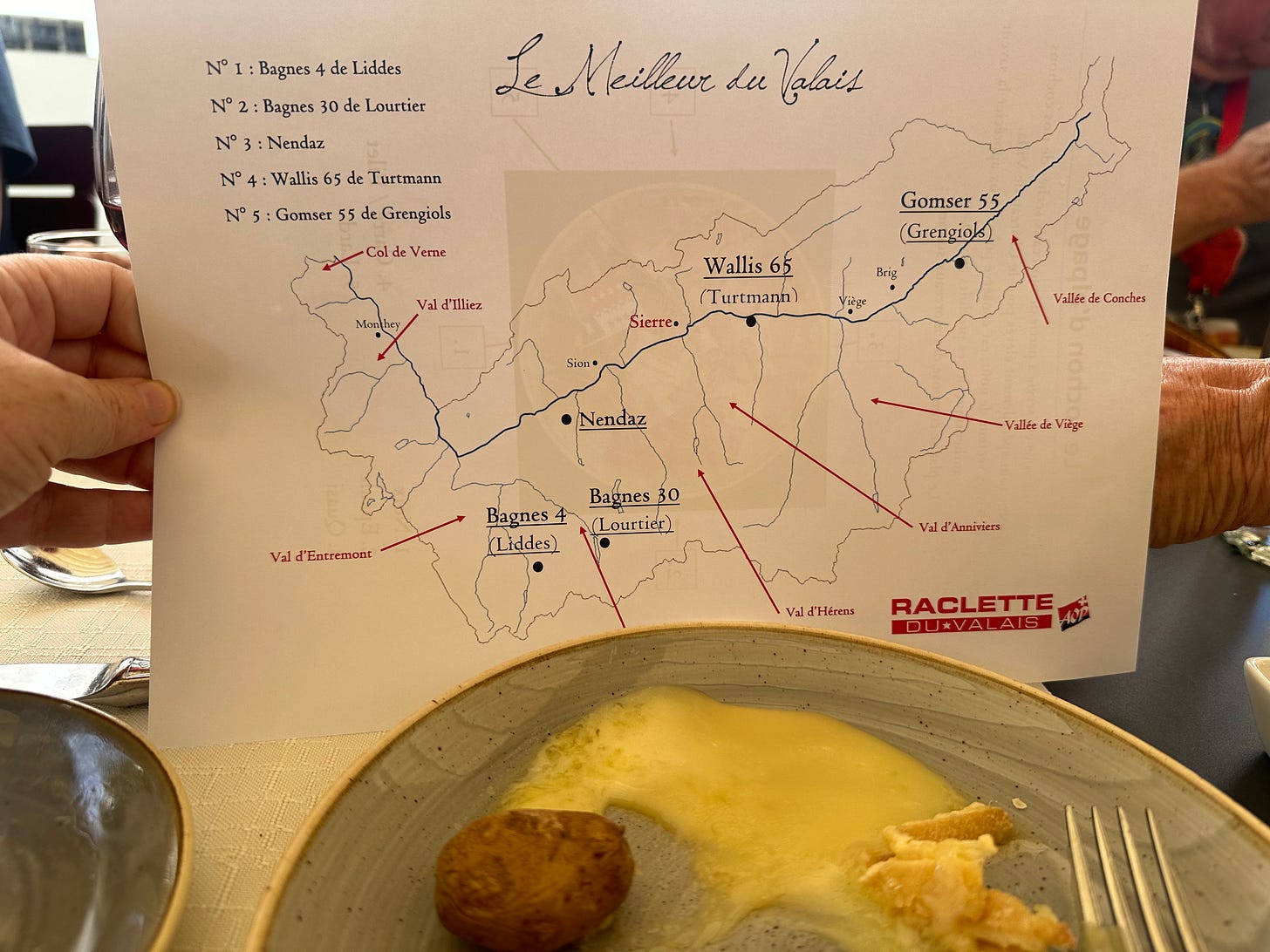Swiss Wines: Another Reason to Visit Switzerland
An exploration of the diverse wine regions of Switzerland
This post highlights my takeaways from my July visit to Switzerland. Have you had Swiss wines? What are your favorites?
first, an announcement. NYC-folks or adjacent, I’ll be hosting some tastings in September including a South African one on the 12th. Sign up here or reach out if you’re interested.
The 2024 gathering of the American Association of Wine Economists in Lausanne gave me the chance to explore a wide array of Swiss wines. The event, hosted by the incomparable Hospitality Business School (EHL), secured many samples of Swiss wine for tasting and allowed us to visit a handful of producers in the Vaud and Valais provinces. A few days in Geneva/Lausanne ahead of the conference also allowed us to sample some Swiss wines in the wild and I was impressed. With the Swiss consuming almost all of their wine production at home (around 1-2% is exported, mostly for prestige), you really have to visit Switzerland to taste the wines.
My takeaway: Tasting Swiss wine should be another reason to visit Switzerland along with its beautiful landscapes. There’s something here for most consumers– light floral crisp Chasselas, minerally Petite Arvine, Rich Savagnin Blanc, surprisingly good Gamay and more. The wines aren’t cheap, but what is in Switzerland? however the quality is good. They also have quite a variety of indigenous grapes or those who have adapted to growing there over centuries and quite a wine growing culture especially around Lake Geneva and the Valais.


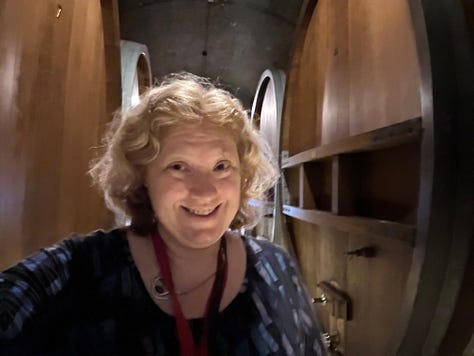
The Swiss drink up Swiss wines: Switzerland is a relatively small producer of wine, but a relatively large wine consumer per capita. Switzerland has around 15 hectares of vine plantings and around 140 million bottles produced, adding up to only 0.4% of global production but over 1% of global consumption. On average the Swiss drink 36 bottles of wine per person per year putting Switzerland in the top 5 after Portugal, Italy and France. Switzerland hasn’t been immune to the structural decline in wine consumption, but on the margins, more of the wine consumed comes from close to home. That leaves little scope for exports, and means that producers tend to cater to the local markets – they tend to prefer lighter clearer, crisp wines that typically don’t need a lot of aging, though more producers are aging their wine.
Many micro-climates, many varietals: Switzerland has 6 main wine regions - most of them in along lakes (Geneva, Vaud, Ticino, Neuchatel) or in sheltered hotspots at high elevations in the Alps (Valais). Many growing regions have steep slopes that are south-facing, and lake proximity helps to extend the growing season, allowing growth earlier in the spring and extending through the fall. Some areas get quite warm (Ticino) and the higher elevation means they are closer to the sun in the summer, getting more direct radiation. These different geographies lend themselves to different grape varietals, mostly but not solely cooler climate varietals. Surprisingly for a small producing nation, there are hundreds of varietals under production. These trends imply that Swiss wine consumption too is very local, with consumption preferences varying depending on regions. Complicating things for consumers – some varietals are known by different names in each region and in some cases new names compared to the growing of these grapes in France and other producers. Still, it’s a set of regions worth taking the time to get to know.
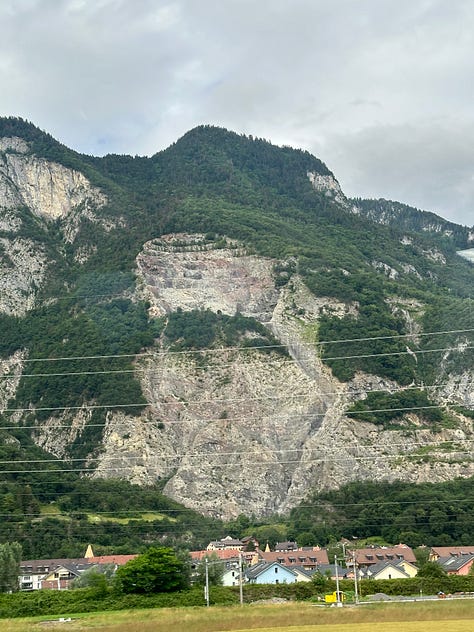
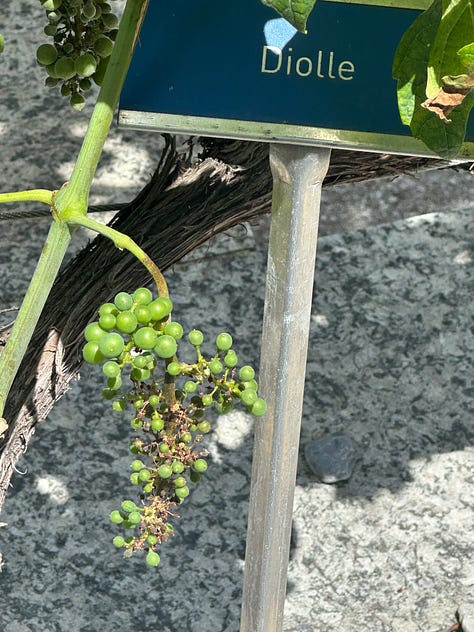
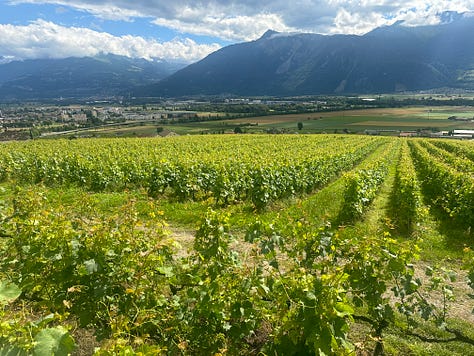
Swiss wine tends to be pricey, but good quality: Like many other Swiss products, wine prices are on the expensive side. These reflect high labor and land costs, meaning that producers have focused on quality. The steep slopes that dominate wine regions require extensive work by hand often with sharp gradients, meaning that the total number of hours to produce a bottle of wine tend to be higher in Switzerland than many other regions. Working hours range from 400-1500/hectare, meaning that even flatter Geneva (400 average) area tends to involve more hours of work per hectare than the Bordeaux average (300). Other steeper areas like the Valais can range from 1000 with some areas requiring 2000 hours per hectare over the season. Like with other Swiss agriculture, subsidies help to cushion the blow for producers and partly reduce the price they have to pass on to consumers. Still, Switzerland is not a source for cheap wine. We did find some great examples to have value compared to high quality aged minerality French wines.
Chasselas the most known Swiss Grape: One grape, Chasselas accounts for almost 30% of all domestic production (Pinot Noir accounts for almost a similar amount). Chasselas, an indigenous swiss grape, is a thin-skinned grape with floral and light fruit especially sweeter stone fruit aromas. It tends to be somewhat neutral or light in body, lower in acid. It is drunk often on its own, with winter raclette and fondue (and mixed into the latter). It is grown across many Swiss regions but is most notable in the Vaud region of the Lavaux and in the Valais where it is called Fendant (melting). It’s the most distinctive and known of the Swiss varietals and one that is barely grown outside of Switzerland. Although it can be blended with other white varietals in France, and even from one producer (Quail’s Gate) in British Columbia. It’s a distinctive wine and worth trying when in Switzerland, especially for Apres ski.
The most known Chasselas is grown in the Lavaux region of the Vaud to the east of Lausanne around Lake Geneva (Leman). This area is steep sloped, has its own unique stone terrassing techniques that have made the region a Unesco world heritage site and is a great place for hiking, biking and walking between vineyards if you’re up for activity or as we did, taking the small petit train. The small roads between the hillside towns don’t all allow cars, and definitely not buses. This is still a region of many small producers, including some that are still intermittent growers. Some cooperative persist like the Union Viticole of Cully we visited but consolidation is on the way as it is harder to find workers.
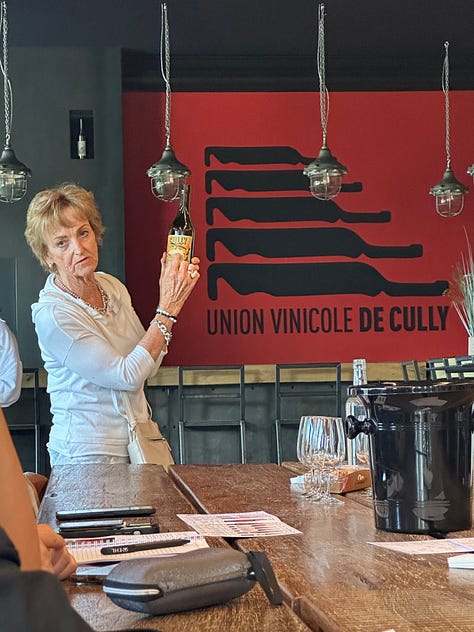

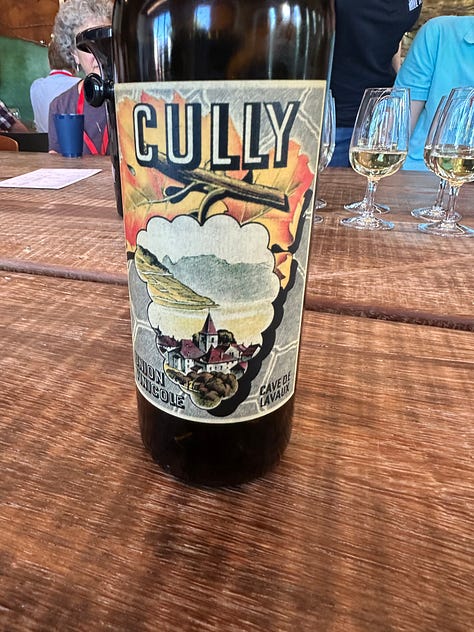
One can also see the vineyards well from the water (a fun day trip from Montreux or Lausanne). Just beware of thunderstorms off the lake. As a side note, Lake Geneva definitely seems a region of variable summer weather – One of the few non-British places where “if you don’t like the weather” wait 5 minutes, seems accurate.
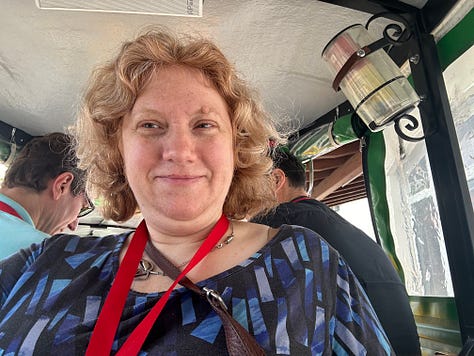
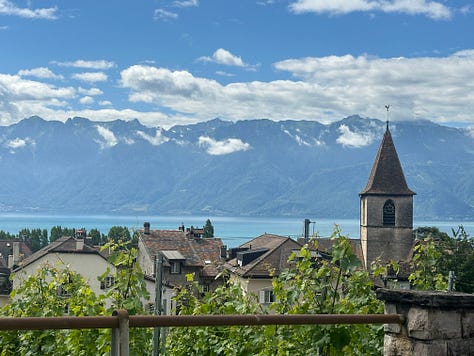
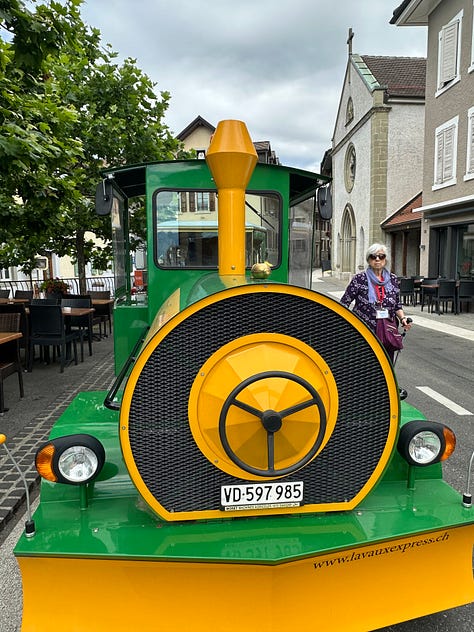
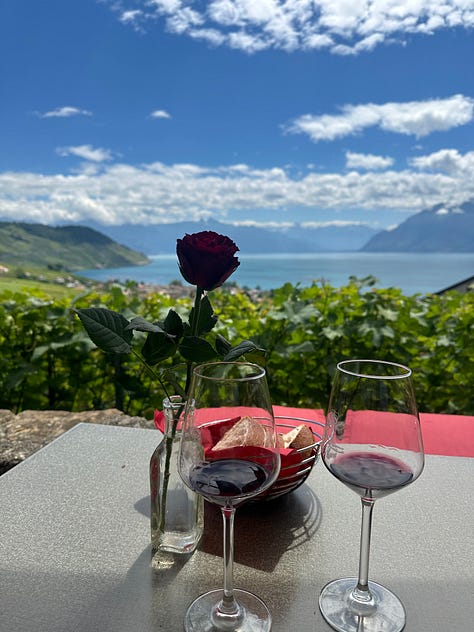

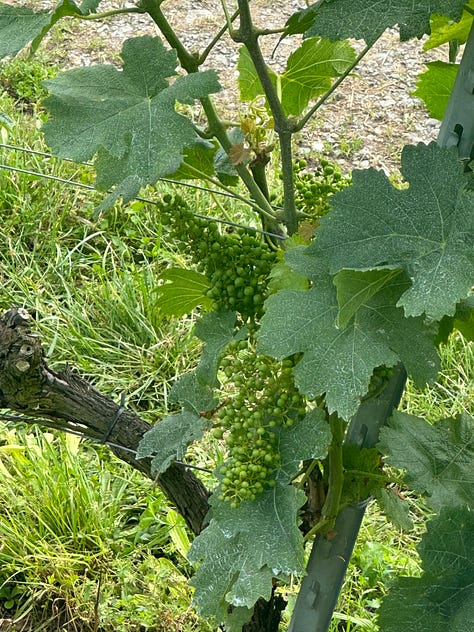
Chasselas can age, taking on more honey, dried herb and dried flower notes, but the Swiss typically drink it young. The style preferred by most Swiss producers is crisp and light though house styles varied. If you like light and slightly neutral, Chasselas may be your fave. I gravitated more towards other also unique indigenous varietals.
Try Valais for higher minerality intense, but still ripe whites: The Valais region sits at high elevation between the Eastern end of Lake Geneva and the Alps. The elevation helps with sizeable diurnal shifts and brings long sunny days at least in the summer. This helps retain acidity and lead to ripe grapes. A range of soils create some interesting minerality. Like the neighboring Vaud, the winery areas tend to be very steep, making them difficult and expensive to work. Some areas we saw could only be accessed via funicular and involved very difficult pruning and harvesting. Yields are low, adding to flavor concentration, but also boosting price.
Among the new-to-me varietals was my new favorite white varietal, Petite Arvine. Also known as Arvine, it is most known in the area of Fully, but is increasingly grown throughout the region, with some great examples near Sierre. Arvine has citrus grape fruit flavors and some lighter stone fruit, high acidity and lovely minerality. We had many great examples but one of the best was the Histoire d’enfer, an organic producer as well as the Cave des Amis, run by two brothers who welcomed us to their winery. Pierre and Manu produce the full range of wines, but I particularly liked their Arvine grown in the vineyard near chestnut trees – NYC folks, if you ask nicely, I might even open up a bottle some time.
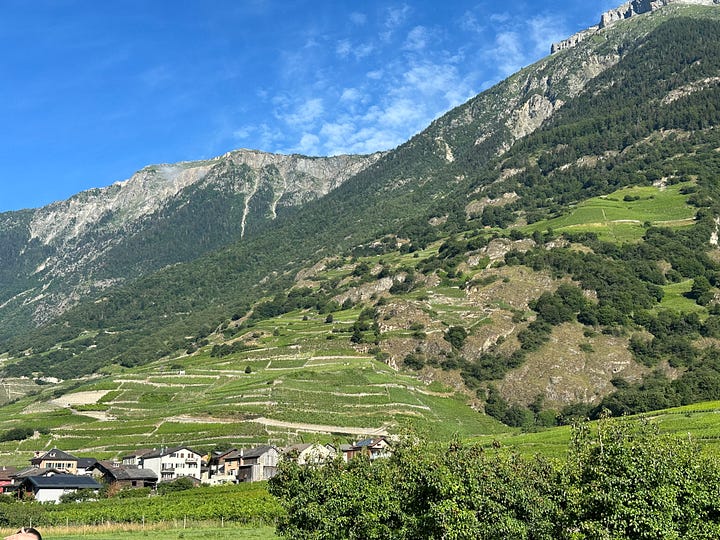

In the Valais and elsewhere also enjoyed a varietal the Swiss call Heida or Paien (AKA Savagnin Blanc) It tended to be rich, well balanced, with good spicy notes with use of neutral oak. Unlike in the Jura it is rarely vinified in a “vin jaune style” but still rich and often in a somewhat oxidative style. We found it hard to go wrong with Arvine and Heida/Paien and both cut through a very rich raclette lunch we had in Sierre, though it was almost a little warm for such amazing regional cheeses. On the red side, Cornalin could be a nice medium bodied red with some herbaceous notes. Confusing, Cornalin is used to describe several different varietals depending on the region.
The Valais also produces a sizable quantity of Chasselas which they call Fendant as well as some Syrah and even some Cabernet Franc. However, the reds tended to be lighter body, more akin to cooler climate wines. Overall, much of Swiss production is made to be drunk young and fresh. We found an interesting example of fresh, clear but concentrated wines at the winery of Clement Luisier, still the youngest vintner in Switzerland. Clement exemplifies a broader trend in the Swiss market in which long-time growing families begin to make wine from their own grapes rather than selling it to larger producers or cooperatives. Rather than being price takers on grapes, more are adding value and making their own wine. Clement began by making wine with parts of his family production, buying from his parents, gradually absorbing all their production and even more recently buying more land. A real success story – and quite refreshing as well as concentrated wines and one where a house style was clear.
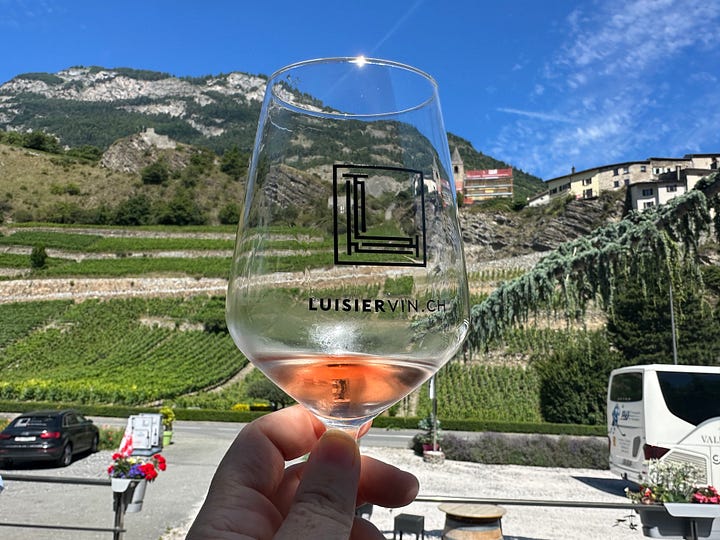

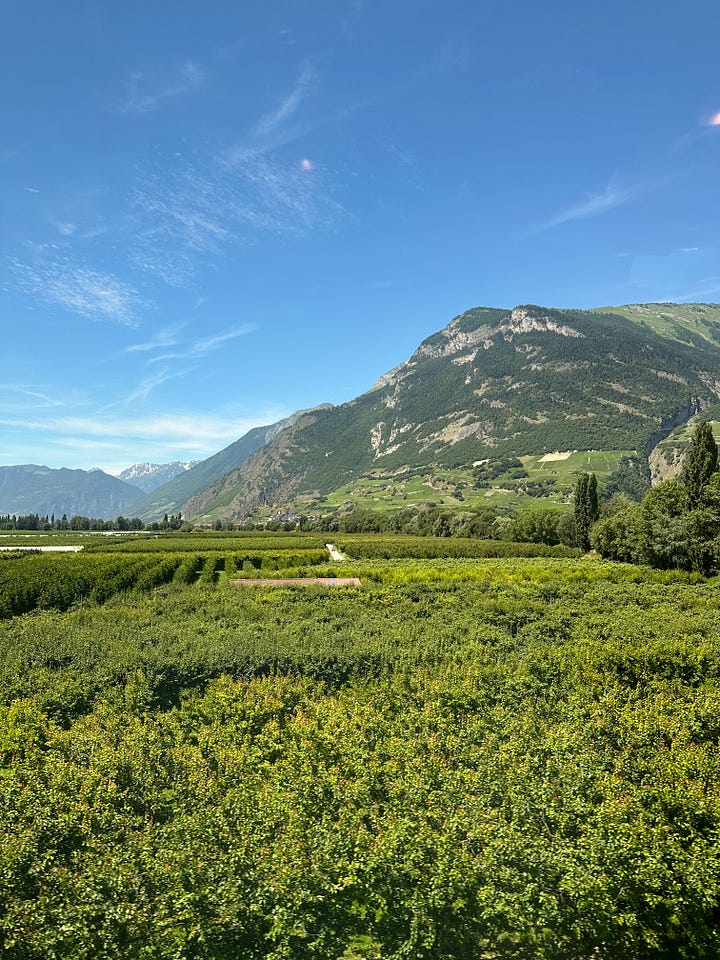
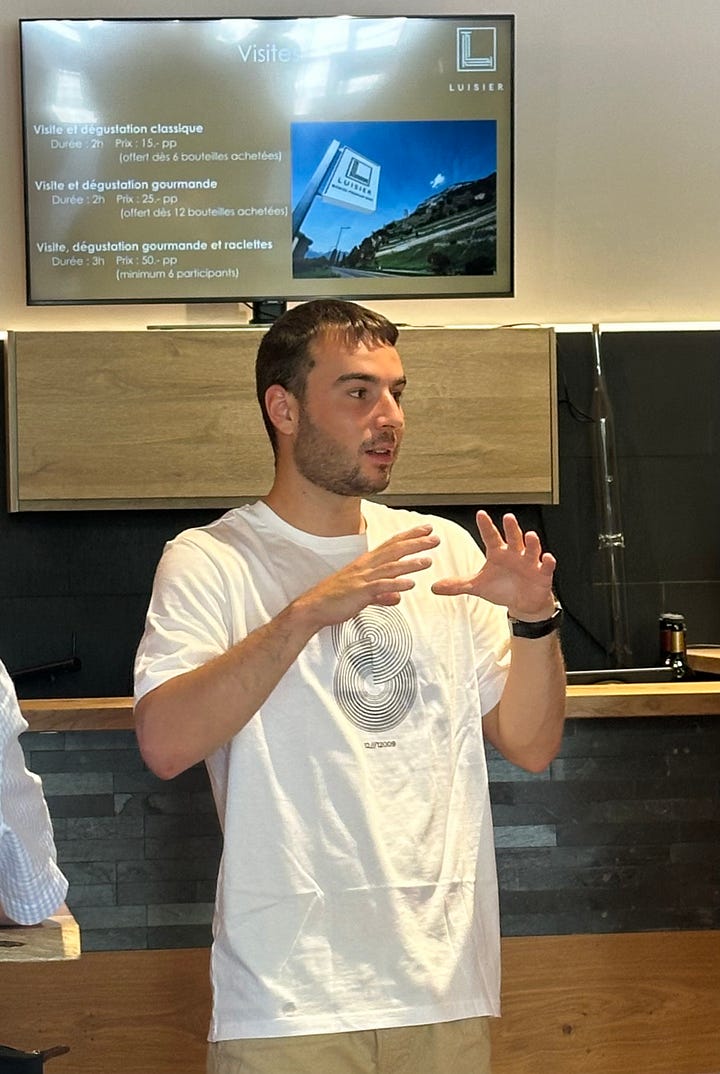
Go Ticino if looking for full-bodied reds. We didn’t get the chance to visit the Ticino, but did enjoy their wines at various tastings. The Italian speaking Ticino area mostly grows Merlot, with a few other varietals. The Ticino is the only Swiss wine area south of the alps has two different main growing areas Sopraceneri to the north, generally a little cooler and Sottoceneri close to Lugano, which is warmer. Merlot is so dominant, that many producers met increased demand for white wines by producing Bianco di Merlot, a white wine from red Merlot grapes. We found the few samples we tasted rich with good minerality and acidity, reflecting the likely earlier picking times. The reds were full bodied, ripe but not over-ripe and balanced, sometimes a bit spicy even. One Merlot Syrah blend was robust balanced and spicy. Worth seeking out if in Switzerland. The Bianco de Merlot, like most Blanc de Noirs, was rich but balanced. Regional roses were also great, tending to produce flavorful robust and slightly darker roses more aligned with Rosados and Rosatos rather than light Provencal roses.
Geneva grows interesting approachable wines. The areas around Geneva were full of vines, suggesting that wine may be replacing some other previously grown products. Geneva has more gentle slopes, some of which can allow mechanical work. We tasted some good sparkling whites, Savagnin blanc and Bordeaux blends. The Gamays were surprising, perhaps since they tended to be full bodied, slightly more time on the skins and much less likely to use carbonic maceration than their younger French counterparts. There are some local clones of Gamay which have adapted to Geneve and other related areas. These tended to be more complex, have more structured tannins than some younger Beaujolais.
Organic/natural wines on the rise: As with other regions, the number of producers aiming for organic production is on the rise though some regions find this easier than others. The sunny dry area of the Valais may lend itself more towards organic and biodynamic wines given less need for sprays, while the wetter Lavaux seems to be more challenging. Some regions are experimenting with PIWIs (hybrids cultivated to be more fungus resistant, which could reduce the need for spraying. However, some regions, like other old world counterparts are resistant. There is more PIWI and experimentation in Geneva, around Zurich and other areas that are also more open to a wider range of varietals.
Increasing demand from tourist and local hospitality: Before this visit, I really hadn’t been aware of the breadth of Swiss wines or even that Switzerland produced much wine, let alone quality. While I was a less dedicated wine student back then, I am sure I would have tried some out for the novelty had I been aware. This time, it seemed like Swiss wines were on many restaurant menus. In part this reflects the very low share of exports (around 1-2% of production). However, it also seems as though the Swiss hospitality industry was doing a lot more to promote and use its wines. Our Geneva hotel had a Geneva Gamay on its by the glass list and the Bayview at the President Wilson had 4 out of 5 Swiss wines for their wine pairings (a super creative tasty menu worth the $$$ splurge). Others tended at least to have a few or many on the list. No wonder the increase in production has been absorbed at home.
Useful materials
Style, Sue: A Landscape of Swiss Wine: A Wine-lovers tour of Switzerland This tour of Swiss wines has brief introductions of the region but mostly surveys the individual producers. A useful way to identify wines to watch when you are in country, though it might be a tad overwhelming at first with all of the new names/varietals. The book is particularly strong on its stories about the different producers and Style’s “wines to look out for” section in each small chapter.
Jose Villamoz . Jose is a wine consultant in Switzerland and has been heavily involved in helping producers nurture almost abandoned varietals and pick the best clones.




